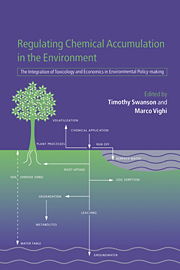 Regulating Chemical Accumulation in the Environment
Regulating Chemical Accumulation in the Environment Published online by Cambridge University Press: 17 August 2009
Introduction
The potential harmfulness of a chemical in the environment depends on several major properties: toxicity to organisms, bioaccumulation in tissues, persistence, mobility and distribution patterns in environmental compartments. Historically, the focus of ecotoxicology was on the first property, toxicity, and techniques were devised to enable maximum concentrations of no harmful effect to be established, usually using responses measured in whole organisms. These concentrations then formed the basis of environmental quality standards.
For many years, these studies played a vital role in the control of the major causes of chemical pollution from industry. However, in the past three decades, there has been an increasing awareness of the special importance of persistent chemicals, which can be transported and detected far from their original source; this problem was highlighted by the discovery of widespread environmental contamination by DDT and later by polychlorinated biphenyls (PCBs). Organisms over a wide area could be exposed to low concentrations of such substances for a long period of time. Ecotoxicologists then began to search for very sensitive biological responses in order to detect the effect, if any, of these low concentrations.
Considerable attention was focused on organismal effects at the cellular or subcellular level, where they first become apparent. These were often found at exposure concentrations lower than those predicted to be safe from tests on whole organisms. The ensuing scientific and political debate served only to cloud the validity of existing environmental quality standards, and indeed shed doubt on the value of ecotoxicological data in pollution prevention and control.
At the same time, the definition of pollution was changing.
To save this book to your Kindle, first ensure [email protected] is added to your Approved Personal Document E-mail List under your Personal Document Settings on the Manage Your Content and Devices page of your Amazon account. Then enter the ‘name’ part of your Kindle email address below. Find out more about saving to your Kindle.
Note you can select to save to either the @free.kindle.com or @kindle.com variations. ‘@free.kindle.com’ emails are free but can only be saved to your device when it is connected to wi-fi. ‘@kindle.com’ emails can be delivered even when you are not connected to wi-fi, but note that service fees apply.
Find out more about the Kindle Personal Document Service.
To save content items to your account, please confirm that you agree to abide by our usage policies. If this is the first time you use this feature, you will be asked to authorise Cambridge Core to connect with your account. Find out more about saving content to Dropbox.
To save content items to your account, please confirm that you agree to abide by our usage policies. If this is the first time you use this feature, you will be asked to authorise Cambridge Core to connect with your account. Find out more about saving content to Google Drive.